Exploring Wave Runner Surfboards in Kiteboarding
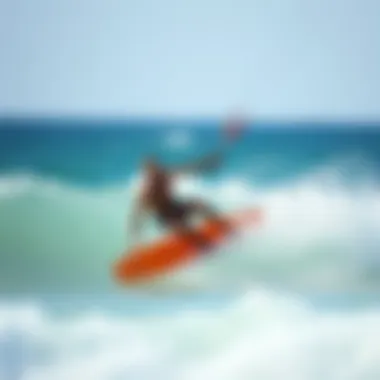
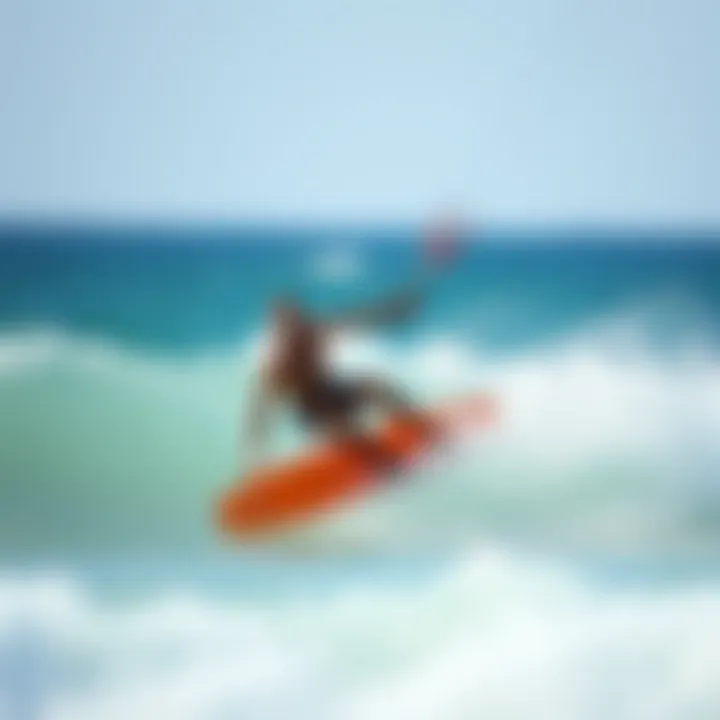
Intro
Wave runner surfboards have carved a niche within the expansive universe of kiteboarding, merging performance with creative thrill. As kiteboarding continues to grow, understanding the unique aspects of wave runner surfboards becomes vital for both novices and seasoned riders alike. This article sheds light on the intricate design elements, material specifications, and the engaging ride experience they facilitate. We will examine various factors influencing the choice of these surfboards, taking a broader look at their presence within the kiteboarding community, including safety considerations and environmental impacts. With this exploration, you're geared up to grasp not only the mechanics of wave runner surfboards but also their deeper significance in kiteboarding culture.
Gear Selection
Selecting the right gear is a pivotal step in maximizing your kiteboarding experience. This phase begins with understanding the components that define your performance on the water.
Types of Kites
Various kite types exist, each suited for different conditions and rider styles. Here's a brief overview:
- Foil Kites: These are excellent for light wind conditions. They fly efficiently and can generate significant lift.
- Frame Kites: Ideal for stronger winds, these kites provide stable power and control, which is beneficial for tricks.
- Hybrid Kites: A mix of both foil and frame designs, hybrids are versatile and easy to handle in a variety of conditions.
When choosing a kite, consider the wind conditions you'll primarily encounter, as well as your own skill level. A seasoned rider might prefer a frame kite for its power, while a beginner might find a foil kite more forgiving.
Choosing the Right Board
Selecting your wave runner surfboard requires careful contemplation of several factors.
- Size and Shape: The dimension of the board influences stability and maneuverability. A shorter board is more agile while a longer board offers more stability in choppy waters.
- Material Considerations: Materials like epoxy or foam board affect weight and durability. Epoxy boards are lightweight and responsive, while foam boards provide added durability, especially for rough use.
- Rockers and Rails: The rocker is the curve from the nose to the tail of the board; a moderate rocker suits various conditions. Rails determine how the board interacts with water. Thicker rails offer more forgiveness and grip.
Remember to also factor in your skill level and the riding style you aim to pursue.
"The right board can turn an average rider into a skilled one; it's your connection to the water."
As you choose your gear, keep in mind the importance of aligning with your personal riding goals while catering to the conditions you face most.
Skill Development
Once you have your gear sorted, the next step is skill development. Here, we’ll explore essential techniques and provide progression tips to refine your kiteboarding abilities.
Essential Techniques
Familiarizing yourself with core techniques can significantly elevate your riding experience.
- Body Positioning: Proper stance is crucial. Keep your knees bent and weight centered over the board for optimal balance.
- Edge Control: Learning how to steer and navigate curves by shifting your weight will greatly enhance your maneuverability.
- Jumping Technique: Start with small hops before attempting larger airs. Focus on timing your jump with kite pull for effective lift.
Progression Tips
To bolster your growth as a kiteboarder, keep these tips in your back pocket:
- Consistency is key. Try to ride regularly, as repetition builds muscle memory.
- Watch experienced riders and analyze their techniques. Learning from others is invaluable.
- Don’t shy away from constructive feedback from instructors or fellow riders. Adaptability is an essential trait in learning.
As you embark on your journey in kiteboarding with wave runner surfboards, these insights will guide you through the process of mastering the art. With the right gear, skill set, and an understanding of the sport's dynamics, you're well-equipped to dive deeper into this exhilarating pursuit. Stay tuned for an exploration of broader aspects like safety considerations and the environmental footprint associated with this thrilling sport.
Understanding Wave Runner Surfboards
When diving into the realm of kiteboarding, one cannot overlook the vital role that wave runner surfboards play. These surfboards are not mere accessories; they embody the spirit of the sport and contribute to the overall experience of riding the waves. Grasping the concept of wave runner surfboards is essential for anyone looking to refine their skills or connect deeply with the kiteboarding community. This section aims to illuminate various aspects—definition, historical context and significance—that make understanding these boards critical for both new and experienced riders alike.
Definition and Overview
A wave runner surfboard, in simple terms, is a specialized type of surfboard designed for use in kiteboarding. They are uniquely crafted to facilitate better maneuverability on the waves while being pulled by a kite. Unlike traditional surfboards, wave runners typically feature enhanced hydrodynamics, enabling riders to slice through water at impressive speeds. Generally, these boards have a foam core with fiberglass layers that contribute to their light weight, allowing for smoother rides and easier handling during dynamic aerial maneuvers.
Historical Context
The evolution of wave runner surfboards can be traced back to the late 20th century when kiteboarding began to gain traction. Initially, riders used modified surfboards, but as the sport grew, so did the need for equipment that could withstand the unique challenges posed by kiteboarding conditions. Manufacturers started developing boards specifically tailored to the sport, reflecting changes in design philosophies and material innovations. Over the years, improvements in technology have led to the integration of advanced materials, making modern boards not just lighter but also more resilient and agile.
Significance in Kiteboarding
Understanding wave runner surfboards transcends mere interest in gear; it's also about grasping their influence on kiteboarding as a whole. They serve as a bridge that connects riders to the ocean, permitting an exhilarating exchange between wind and water. Riders who understand their boards are more likely to capitalize on the boards’ strengths, leading to enhanced performance. Furthermore, their significance can be seen in various competitive events where skilled riders showcase their techniques, demonstrating how board design can dramatically affect performance outcomes.
Wave runner surfboards represent not just equipment but a philosophy—a commitment to embracing the elements and the thrill of the sea. "In the world of kiteboarding, having the right board can either make or break your ride." This perspective is echoed by enthusiasts and competitors alike, underscoring the need for kiteboarders to familiarize themselves with their gear and harness the full potential of their wave riding experience.
As kiteboarding continues to evolve, so too does the technology and design behind wave runner surfboards. This makes the study of their characteristics and historical development a worthy pursuit for anyone passionate about the sport.
Design Elements of Wave Runner Surfboards
The design elements of wave runner surfboards play a vital role in determining their functionality and performance in the water. These characteristics not only cater to the physical demands of kiteboarding but also reflect the nuanced artistry involved in the crafting of each board. Understanding these elements helps kiteboarders, instructors, and enthusiasts choose the right equipment, enhancing both their experience and safety.
Material Composition
Foam Core
The foam core is the heart of a wave runner surfboard. Typically made from expanded polystyrene or polyurethane, it contributes substantially to the board's buoyancy and ability to float on water. This characteristic allows for a responsive ride, which is critical when navigating the waves. The lightweight nature of foam makes for easier handling and maneuverability, which surely appeals to riders of all skill levels.
A unique feature of foam cores is their resilience. They can endure substantial impacts from crashing waves, making them particularly popular among those who enjoy more aggressive riding styles. However, one might note that while foam cores are beneficial for a bouncy ride, they can be less durable in the long term compared to other materials, especially if not maintained properly.
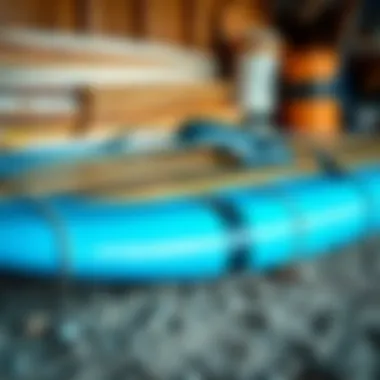
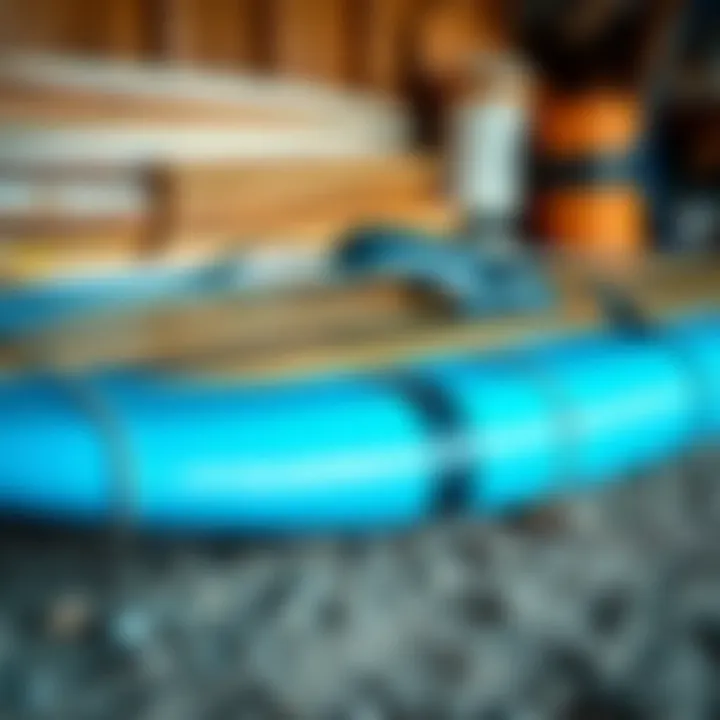
Fiberglass Layers
Fiberglass layers add significant strength to the structure of wave runner surfboards. These layers are bonded together with resins to create a hard shell that can withstand the rigors of relentless ocean conditions. The laminate effect not only enhances durability but also provides a level of stiffness that contributes to performance, allowing for sharper turns and dynamic movements.
What makes fiberglass such a beneficial choice is its balance between strength and weight. This composite material is favored for its ability to maintain structural integrity without adding unnecessary bulk. Nevertheless, fiberglass can be prone to cracking under extreme pressure or heavy use, which is something to consider for extreme riders.
Environmental Considerations
As discussions about sustainability grow, environmental considerations in the manufacturing of wave runner surfboards are becoming increasingly important. Manufacturers are starting to implement eco-friendly practices, such as using recycled materials and water-based resins, to reduce the environmental footprint of their boards. This shift not only contributes positively to the ecosystem but also resonates with an environmentally conscious consumer base.
The unique feature of these sustainable materials is their ability to deliver high-quality performance while promoting an eco-friendlier approach. This is especially relevant today, as the traditional surfboard crafting methods often result in significant waste and pollution. The downside, however, could be the cost associated with these more sustainable options, which may not fit all budgets but offer peace of mind for those who value the planet.
Shape and Size Variations
Shortboards vs Longboards
When it comes to shape and size, the debate between shortboards and longboards can be quite spirited. Shortboards, with their compact design, are ideal for maneuverability and speed. They allow riders to perform quick turns and dynamic tricks, contributing to a high-adrenaline experience. The shorter length, however, can offer less stability, which may not be ideal for beginners or in choppy waters.
On the other hand, longboards provide a stable platform that's suited for cruising and are generally more forgiving for those just starting out. The extended length enhances buoyancy, allowing for smoother rides over larger waves. Unfortunately, they lack the same agility as their shorter counterparts, limiting the variety of tricks one can perform.
Tail Shapes
The shape of the tail on a wave runner surfboard can dramatically influence how it rides. Different tail shapes, such as swallows, squares, and rounded, each serve specific functions. For instance, a square tail offers more hold and stability in the water, making it easier to maintain speed when cutting through larger waves. Conversely, a swallowtail reduces drag, enabling sharper turns and increased maneuverability.
Each tail shape carries its unique advantages and disadvantages, often aligning closely with the type of riding one plans to undertake. It's essential to match the tail shape with one's skill level and the conditions expected for the riding session.
Rocker Profiles
Rocker profiles, referring to the curvature of the board from nose to tail, can make or break a ride. A pronounced rocker involves more curvature, which aids in maneuverability and plays well in choppy waters. It allows the rider to pivot with ease without submerging too much of the board, leading to an enhanced performance when carving through the waves.
In contrast, a flatter rocker enhances speed and stability, providing an ideal ride for those who prefer sprints along the wave. However, this can make turning a bit challenging, especially for novice riders still learning the ropes. Each profile has its merits, and the choice should reflect the rider's intentions and comfort with the surfboard dynamics.
Tech Innovations in Design
Hydrodynamics
With advances in technology, hydrodynamics in wave runner surfboards have taken a significant leap. Designs are carefully tailored to minimize drag and enhance glide efficiency through water. This is an absolute boon for kiteboarders who desire speed and agility in their rides.
Specially crafted fins and hull shapes can drastically improve how a board interacts with water, allowing for more powerful strokes and smoother rides across varying conditions. The downside is that highly specialized boards can sometimes sacrifice versatility for specific performance traits.
Weight Reduction Techniques
Innovations in weight reduction techniques shape the future of wave runner surfboards. Manufacturers are finding new ways to strip down the weight without compromising integrity. For example, using honeycomb constructions or advanced composites can be an intelligent choice, as these methods contribute to both reduced weight and increased responsiveness.
However, it's worth noting that lightweight boards may be prone to damage. Increased care is needed to keep them in top shape, especially in rocky or highly corrosive environments.
Customizable Features
Customization is becoming a significant trend in wave runner surfboards. Options for different colors, sizes, and grips allow riders to tailor their boards to their personal style and needs. Riders can adjust their boards according to specific environments or preferences, creating a truly unique surfing experience.
Some shops even offer custom graphics, allowing for personal expression on the waves. The downside, however, could be a longer waiting time for personalized boards, which might not appeal to those eager to hit the water quickly.
Performance Characteristics
The performance characteristics of wave runner surfboards play a pivotal role in defining their utility and enjoyment in the sport of kiteboarding. These boards are not just simple planks of fiberglass and foam; they are finely-tuned instruments crafted for speed, stability, and responsiveness. Understanding these attributes can greatly enhance a rider's experience and expand their skillset.
Speed and Maneuverability
Speed and maneuverability are essential for any kiteboarder looking to maximize their time on the water. Wave runner surfboards are designed to slice through waves, giving riders that thrill of acceleration. The hydro dynamics of these boards allow them to glide effortlessly, translating kite power into forward motion.
A well-designed wave runner can make even the most novice rider feel like a pro, allowing easy transitions from carving turns to executing jumps. Many enthusiasts find that the right board can dramatically increase their control and confidence. Factors that contribute to speed and maneuverability include:
- Shape: The outline of the board can directly affect how it behaves in the water. Narrower designs tend to be faster, while wider boards offer more stability at high speeds.
- Fin Configuration: The placement and type of fins can change how sharply a board turns. For instance, a quad fin setup often allows for tighter turns compared to a twin fin design.
- Rocker Profile: A flatter rocker can give more speed on flat water, while a more pronounced rocker helps with maneuverability in choppy conditions.
In summary, speed and maneuverability are intertwined, with each impacting how riders interact with their environment.
Stability in Different Conditions
Stability is crucial when riding across varied water conditions. Wave runner surfboards are built to handle a range of scenarios, from small swells to sizable open ocean waves. The key to stability lies in the board's design and how it's balanced on the water. A stable board allows riders to maintain control even when facing the elements.
There are several factors that affect stability:
- Width: Wider boards offer more surface area and thus greater balance, which can be advantageous for beginners.
- Volume Distribution: How volume is distributed in the board influences buoyancy and stability. A board with a more balanced volume tends to perform better across different conditions.
- Tail Design: The tail of the board plays an important role in how it sits in the water. A rounded tail can enhance stability, while a swallow tail might allow for quicker pivoting.
Ultimately, a stable board instills more confidence in riders, allowing them to push boundaries and explore new maneuvers.
Sensitivity to Weather and Water Conditions
Wave runner surfboards are remarkably responsive to changes in weather and water conditions. Understanding this sensitivity can be key to making the most of the riding experience. Boards react differently as wind speed and wave height fluctuate, influencing a rider's strategy and ability on the water.
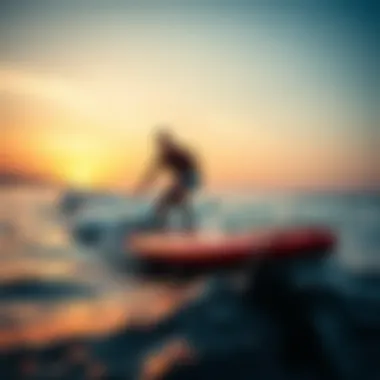
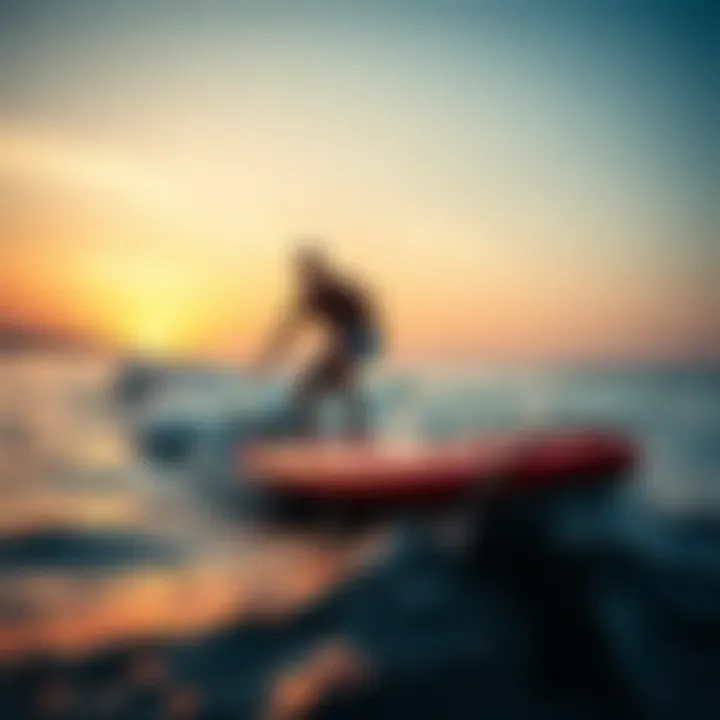
Key considerations include:
- Wind Conditions: Higher winds can boost a board's speed, but too much wind might necessitate a different board or adjustments in technique to maintain control.
- Wave Patterns: Some boards excel in choppy waters, while others shine in clean, well-formed waves. Recognizing the characteristics of each board can allow riders to select the best tool for the job.
- Water Temperature: Colder water can affect buoyancy and responsiveness of materials, potentially leading to a less desirable riding experience.
Being aware of the sensitivity of your wave runner surfboard to these changing conditions can provide a competitive edge.
Choosing a Wave Runner Surfboard
Choosing a wave runner surfboard can feel akin to picking a dance partner—you want the right kind of balance and responsiveness to truly enjoy the ride. This decision isn’t just about picking a flashy color; it’s about understanding how different boards work with your skill set and the conditions you’ll be facing on the waves. It sets the tone for your entire experience on the water, whether you’re paddling out at dawn or carving turns in the afternoon sun.
Understanding the nuances of this topic involves several elements: evaluating your skill level, the intended use of the surfboard, and your budget. Each of these factors plays a crucial role in narrowing down the myriad of options available, ultimately leading to a board that enhances your overall kiteboarding experience.
Assessing Skill Level
Before you dive into the selection process, assessing your skill level is paramount. Whether you're a novice dipping your toes into the sport or a seasoned pro tackling challenging waves, your skill level heavily influences which surfboard models would suit you best.
For beginners, a wider and more stable board is often recommended. Such boards provide a solid base, making it easier to balance and catch waves. As individuals progress, those who have honed their skills may choose more agile models that offer advanced maneuverability. Thus, recognizing your current abilities and future aspirations can lead to selecting a surfboard that aligns with your journey.
Evaluating Intended Use
When considering a wave runner surfboard, it’s essential to evaluate how you plan to use it. Understanding where you fit within the riding spectrum can streamline your board selection.
Recreational vs Competitive Riding
Recreational riding and competitive riding represent two distinct approaches, each with its appealing traits. For the casual rider—those looking to have fun during weekends or enjoying the surf with friends—a recreational board prioritizes comfort and stability. The unique characteristic here is that these boards are designed to provide an enjoyable experience without the pressure of performance metrics.
In contrast, competitive riders seek precision and agility, with boards tailored to execute high-level maneuvers. In this group, the advantage lies in lightweight materials and refined shapes, designed for speed and responsiveness. Therefore, deciding whether you're a weekend warrior or a competitor will play a pivotal role in shaping your choice.
Wave Size and Type
Wave size and type also significantly impacts your decision-making in terms of surfboard selection. Small, mushy waves may be better suited for a shorter, wider board, which facilitates easier paddling and wave catching. Conversely, larger, more powerful waves typically call for a longer and narrower design that can handle the speed and force.
The crux here is matching your board to the environment you will be riding. Every surfboard has its ‘sweet spot’ regarding wave conditions, and knowing this can maximize your fun while reducing the frustrations of unsuitable gear.
Budget Considerations
Lastly, budget considerations can’t be ignored when choosing a wave runner surfboard. It’s essential to find a model that meets both your performance needs and your wallet’s capacity.
You might be tempted to splurge on top-of-the-line boards, lured by the promise of premium performance. However, many mid-range options deliver excellent quality and capabilities suitable for developing riders or those testing the waters of this exhilarating sport. Remember, making a savvy financial decision doesn't imply compromising on quality. Instead, it reflects a thoughtful approach to your kiteboarding journey.
Wave Riding Techniques with Surfboards
Wave riding, while often seen as the soul of surfing, takes on new dimensions when contextualized within the performance of wave runner surfboards. This section will illuminate why mastering riding techniques is essential—not just for thrill-seekers but for individuals aiming to elevate their surfing experience. Commanding these skills equips kiteboarders with the ability to harness their board's potential thoroughly.
The nuances of riding techniques are key to improving efficiency and enjoyment. Gaining the rhythm of the waves and understanding how to interact with them can result in a more successful ride. Moreover, refining these abilities forms the backbone of a competent kiteboarder.
Basic Riding Skills
At the foundation of any successful wave riding experience is the mastery of basic skills. Simple maneuvers like balancing, paddling, and catching waves may seem rudimentary. However, they pave the way for more complex riding techniques. Gaining proficiency in these techniques can translate into increased confidence both on the board and in the water.
Here are a few core elements that constitute basic riding skills:
- Stance: A balanced stance is crucial. Feet should be shoulder-width apart, with your weight distributed evenly. This stance helps in adapting to changes in wave conditions.
- Paddling: Efficient paddling is necessary for starting a ride. Knowing how to paddle strategically can save energy and help you catch those elusive waves.
- Initiation of Wave Catching: Timing is key. Being in sync with the wave's energy can make or break the ride. Practicing this can elevate your overall performance.
Advanced Maneuvers
Once the basic skills are under your belt, attention shifts toward advanced maneuvers that will enhance your riding. These techniques can amplify your experience on the water and make the ride feel electrifying.
Turns and Jumps
Diving into turns and jumps adds a layer of excitement. Both of these maneuvers contribute directly to the overall goal of optimal wave performance. The key characteristic of turns is their capacity to navigate tight spaces and shift momentum efficiently. Jumps, on the other hand, always bring an adrenaline rush, providing a thrilling visual spectacle.
The unique feature of turns lies in their versatility. They allow riders to adjust direction swiftly, maximizing opportunities to ride different wave faces. However, both turns and jumps necessitate a fine-tuned sense of balance and timing.
Carves and Cutbacks
Carves are about drawing graceful lines on the water, while cutbacks allow surfers to reposition on the wave effectively. The specific aspect of carves emphasizes artistic expression—each carve can be uniquely stylized. Cutbacks, in comparison, highlight strategic movement and responsiveness to wave changes. Both are essential for an engaging ride.
The advantages of mastering these maneuvers include transforming typical rides into thrilling displays of skill and flair. They create a more pleasurable experience, whether riding in competitions or just for fun.
Safety Protocols
While mastering the art of wave riding, adhering to safety protocols can’t be overstated. These not only ensure the rider's well-being but also foster a greater sense of responsibility towards other water enthusiasts.
Equipment Check
An essential part of safety protocols is performing consistent equipment checks. Regular inspection assures that your gear—especially the board and kite—functions properly. This diligence minimizes the risk of unexpected gear malfunctions mid-ride.
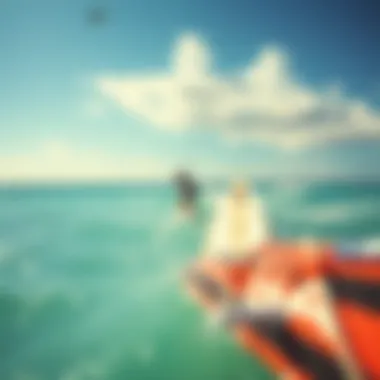
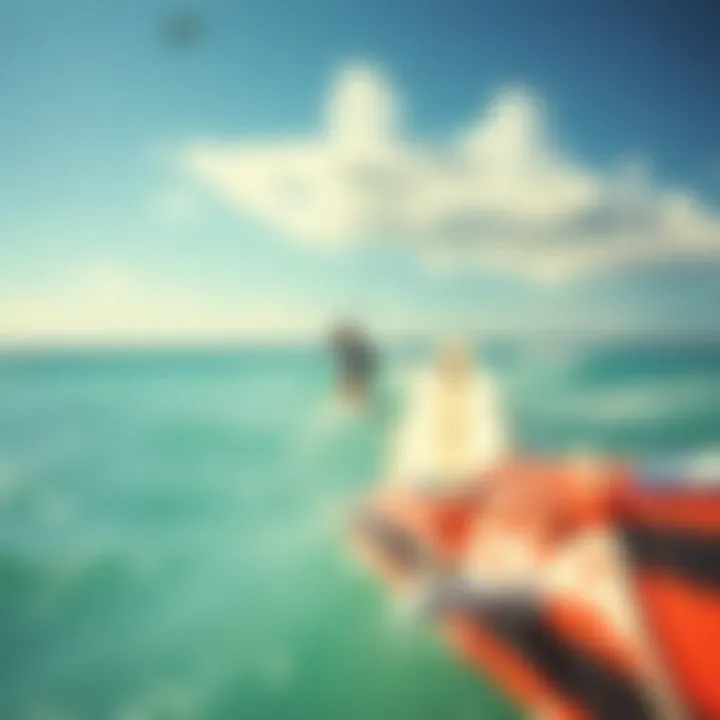
The notable characteristic here is preparation. A quick assessment becomes a beneficial routine that can save lives, particularly in unpredictable water conditions. Neglect can lead to unpleasant surprises, making it crucial to maintain equipment meticulously.
Environmental Awareness
Being aware of your surroundings adds another layer to safety while riding. Recognizing conditions like changing tides, incoming storms, and wildlife can influence not only your ride but other surfers as well. When kiteboarders practice environmental mindfulness, this elevates safety not just for themselves but also promotes a culture of respect within the community.
Connecting wave riding techniques with safety awareness sets an overall foundation for a rewarding experience in the dynamic world of wave runner surfboards. As riders learn how to master these particulars in riding, they open doors to both personal growth and a deeper appreciation of kiteboarding as an art form.
Maintenance of Wave Runner Surfboards
Maintaining your Wave Runner surfboard is as crucial as having the right gear when you hit the waves. A little TLC goes a long way to ensure that your board remains in top-notch condition, allowing for lasting performance and a better riding experience. Just like you wouldn't neglect your favorite pair of running shoes, the same logic applies to your surfboard. Proper maintenance involves not only cleaning but also making necessary repairs and ensuring safe storage.
Cleaning Techniques
Cleaning your surfboard isn't just about aesthetics; it's part of preserving the structural integrity. After a day on the ocean, a rinse with fresh water removes salt, sand, and other residues that can deteriorate the board materials over time. A simple technique involves using a soft sponge or cloth to wipe down the surface gently. Avoid harsh chemicals, as they could damage the board's finish. Regular cleaning helps in maintaining vibrant colors and extends the lifespan of your equipment.
Pro Tip: After rinsing, let your board dry completely before storing it to prevent any mold or mildew.
Repair and Upkeep
Identifying Damage
Noticing damage early is critical to maintaining your board's longevity. Small dings or cracks may seem harmless but can evolve into larger issues if ignored. Look out for changes in the board's texture or visual signs such as discoloration around the damages. This indicates water seepage, which can compromise the foam core. In this article, identifying damage is emphasized as a key aspect of upkeep. It’s not just about spotting visible issues; it's also about being attentive to how the board feels during use. If it begins to feel sluggish or difficult to control, it's time for an assessment.
Key Takeaway: Early detection often relieves bigger, costlier repairs down the line.
DIY Repairs
Diving into DIY repairs not only saves you a chunk of change but also empowers you. The knowledge of how to repair small damages fosters a sense of independence as a kiteboarder. Commonly, repairs involve patching dings with repair kits, which are user-friendly and typically include epoxy resin. Perfecting these skills can give you the confidence to tackle more complicated fixes in the future.
One unique feature of DIY repairs is the immediacy it offers. Rather than waiting weeks or even longer for professional repairs, you can get back on the water quickly. That being said, DIY doesn't mean you should avoid professional help for complex issues. The balance of being able to repair damage and knowing when to seek expert assistance can be crucial.
Storage Recommendations
Storing your Wave Runner surfboard properly can greatly influence its performance and lifespan. When storing, avoid exposing it to extreme temperatures—both hot and cold. Ideally, keep your board indoors in a cool, dry place. Use a board bag for added protection if you’re transporting it, as it shields against dings and scratches. If you have a garage or dedicated storage space, laying it flat is the best bet to prevent warping.
By regularly washing, inspecting for damage, and practicing easy repairs or proper storage techniques, you set yourself up for a successful, enjoyable experience on the waves. Taking these steps ensures that your surfboard stands the test of time, providing you with numerous thrilling rides to come.
Environmental Considerations
The impact of wave runner surfboards extends beyond the thrill of riding the waves; it also touches upon significant environmental considerations. As kiteboarding continues to grow in popularity, understanding how surfboards affect ecosystems becomes crucial. This section delves into the core elements of sustainability, local habitats, and community actions aimed at ocean preservation. Through this exploration, kiteboarders and enthusiasts alike can appreciate the importance of safeguarding the environments they enjoy.
Sustainable Manufacturing Practices
Sustainable manufacturing practices are increasingly important in the production of wave runner surfboards. The conventional methods often involve materials and processes that harm the environment. Manufacturers are recognizing the need to pivot towards more eco-friendly practices.
- Material Selection: Instead of petroleum-based foams, some companies now use recycled materials or bio-based resins that significantly lower carbon footprints.
- Eco-conscious Production Methods: Practices such as reducing water usage and minimizing waste during fabrication can impact the overall ecological footprint.
- Life Cycle Assessments: Many brands are beginning to conduct these assessments to evaluate the environmental impacts from creation to disposal. This thorough analysis helps consumers make informed decisions regarding their purchases.
Impact on Local Ecosystems
Every time a surfboard slices through the water, it affects local ecosystems. The construction and usage of wave runner surfboards can lead to various environmental challenges, particularly if not managed responsibly.
- Water Pollution: Runoff from surfboard production or broken boards entering water bodies can contribute to pollution. It's vital to dispose of or recycle damaged boards properly to minimize damage to marine life.
- Disruption of Natural Habitats: When too many kiteboarders frequent certain areas, it can disturb the local flora and fauna. Awareness and responsible riding can mitigate these impacts.
- Biodiversity Relevance: Protecting local ecosystems can help ensure that marine biodiversity thrives. Healthy environments mean healthier surf conditions, creating a beneficial cycle for both nature and enthusiasts.
Community Initiatives in Ocean Conservation
Community involvement is pivotal in ocean conservation efforts related to wave runner surfboards. Individual and collective actions can amplify the call for responsible kiteboarding practices.
- Cleanup Events: Local groups often organize beach cleanups to remove plastic and debris, ensuring a safer and cleaner environment for both surfers and marine life.
- Educational Workshops: Communities can host workshops to educate riders on minimizing environmental impacts and adopting sustainable practices in surfing culture.
- Partnerships with Conservation Groups: Many surfboard manufacturers collaborate with organizations like the Surfrider Foundation to promote ocean conservation. These partnerships not only enhance brand reputations but also deliver meaningful contributions to ecosystem health.
"The ocean is not just a playground; it's a vital part of our planet's health. Protecting it should be our collective responsibility."
In summary, the environmental considerations surrounding wave runner surfboards underscore the responsibility of the kiteboarding community. By focusing on sustainable practices, understanding the impacts on local ecosystems, and actively participating in conservation initiatives, we can help ensure that the joy of the ride continues in harmony with nature.
Ending: The Future of Wave Runner Surfboards
In contemplating the future of wave runner surfboards, it becomes evident that both innovation and community engagement are pivotal. With advancements in materials and technology paving the way for superior performance, explorers in the kiteboarding scene are bound to see meaningful enhancements. The balance between speed, stability, and maneuverability continues to evolve, offering an unmatched riding experience.
Trends in Design and Technology
The landscape of surfboard design is not static; it's an ever-changing canvas driven by trends driven by riders' feedback and technological advancements. Emerging materials that are lighter and stronger than traditional options—like carbon fiber composites—allow boards to slice through waves more seamlessly.
In addition, companies are increasingly integrating smart technology into surfboards, such as sensors that provide real-time data on performance metrics. Such innovations can help riders adjust their technique or gear on the fly, creating significant advantages on the water. This proactive approach to design not only enhances performance but also resonates with the environmentally-conscious ethos many riders embrace today.
In the realm of aesthetics, personalization stands out. Custom-made designs that reflect individual styles or preferences are gaining more popularity. Riders are interested in unique shapes and appearances, and as such, builders are experimenting with artistry in board design—blending function with flair.
The Role of Community and Collaboration
Community is the lifeblood of kiteboarding culture. As more enthusiasts join in, sharing knowledge and experiences becomes essential. Riding clubs and online forums foster collaboration, and the sharing of insights can lead to the exchange of innovative ideas.
In particular, riders often post about gear feedback, which has a ripple effect on the development of surfboards. Manufacturers who listen to their audience tend to thrive in this competitive landscape.
Additionally, collaborations between brands and local eco-organizations can make a significant impact. The commitment to sustainability in both production and community initiatives strengthens the relationship between riders and the ocean they cherish. As shared values resonate, they help ensure that future generations will be able to enjoy the thrill of riding waves on incredible boards.
Final Thoughts on Wave Riding Experiences
Riding waves brings a profound sense of freedom and connection to nature. This connection often evokes a certain level of responsibility among kiteboarders towards preserving the environments they enjoy.
Looking ahead, it is crucial for practitioners not only to adapt to changing technologies but also to remain mindful of their ecological impact. The balance between enjoying the thrill of the ride and nurturing the ecosystem sets the stage for a richer, more fulfilling wave riding experience in the years to come.
In essence, the wave runner surfboard is not just a tool for sport, but rather a gateway to adventure, community, and ecological stewardship. As the sisterhood and brotherhood of kiteboarders expands, the hope is that they will continue to push the boundaries while fostering a deep respect for the waves that sustain them.















